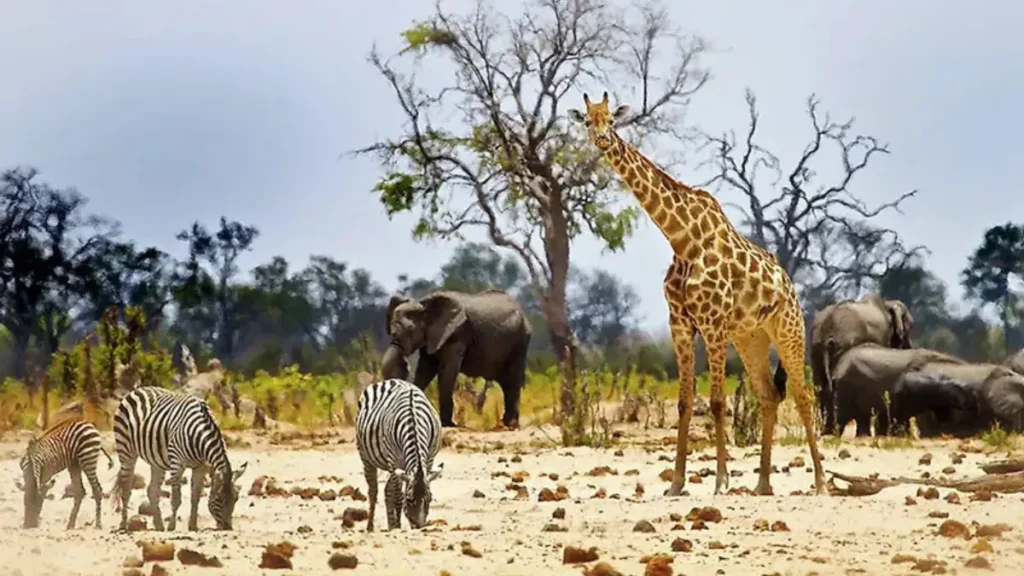Wildlife Conservation: Tasarap Chu, located in the remote and cold Spiti Valley of Himachal Pradesh, has now become the largest conservation reserve in India, covering an area of 1,585 square kilometers. On May 7, 2025, the Himachal Pradesh government officially notified Tasarap Chu as a conservation reserve under Section 36A(1) of the Wildlife (Protection) Act, 1972.

Wildlife Conservation
Previously, the largest conservation reserve in the country was Rapan Chakot in West Bengal, with an area of 1,340.34 sq. km. With its vast expanse, Tasarap Chu has now surpassed it, becoming not only the biggest in the country but also Himachal’s fifth and India’s 146th conservation reserve.
Earlier, conservation reserves like Darlaghat, Naina Devi, Potter Hill, and Shilli were designated in Himachal Pradesh. Tasarap Chu’s unique geographic location makes it extremely valuable in terms of biodiversity and ecological significance.
The reserve is bordered by Ladakh in the north, Malang Nala and the Kibber Wildlife Sanctuary to the east, Kabzima Nala to the south, and the Chandratal Wildlife Sanctuary and Baralacha Pass to the west, extending up to the confluence of Yunam River and Charap Nala.
This region is one of the few zones in Himachal Pradesh known for a dense population of snow leopards (Panthera uncia). It also serves as a watershed for the Charap Nala and functions as a vital wildlife corridor connecting Kibber and Chandratal sanctuaries, thereby playing a critical role in regional Wildlife Conservation and maintaining the ecosystem’s health.
According to Mandar Jevre, Deputy Forest Officer (DFO) of the Spiti Forest Division, the declaration of Tasarap Chu as a conservation reserve is the outcome of an extensive, ground-level process. “We held detailed consultations with local gram panchayats, conducted regional surveys, and deeply analyzed historical ecological data,” he said. Jevre added that the new reserve will promote Wildlife Conservation, research, eco-tourism, trekking, and photography, thereby creating new livelihood opportunities for local communities.
Tasarap Chu is especially known for being a critical habitat for the elusive snow leopard, often referred to as the “ghost of the mountains.” This elusive predator is typically found at altitudes ranging from 3,000 to 5,000 meters, inhabiting cold and rocky terrains. Spiti Valley hosts a relatively higher population density of this endangered species, which is a strong indicator of a healthy mountain ecosystem.
Beyond snow leopards, the region is also home to rare ungulates like the Tibetan wolf, bharal (blue sheep), Himalayan ibex, kiang (wild ass), and Tibetan argali. Among birds, the rosefinch, Tibetan raven, and yellow-billed chough enrich the area’s avifauna. Such biodiversity elevates the conservation value of the region on both national and international levels.
The management of the Tasarap Chu Conservation Reserve will be overseen by a Reserve Management Committee, which will include representatives from local panchayats. The committee’s objective will be to balance the conservation priorities with the livelihood needs of local residents, ensuring sustainable Wildlife Conservation.
Amitabh Gautam, Principal Chief Conservator of Forests and Chief Wildlife Warden of Himachal Pradesh, stated that this notification will energize community-based conservation efforts in the state and enable local people to become active participants in the conservation process.
Also read: Nahargarh Biological Park: A Serene Wildlife Escape in Jaipur

What Are Conservation Reserves?
Conservation reserves are ecologically sensitive areas that lie outside the boundaries of national parks and wildlife sanctuaries but are still crucial for biodiversity. These areas are protected to maintain the natural habitat of wildlife and encourage community participation in sustainable conservation practices.
Tasarap Chu is not just a mapped territory; it symbolizes a new direction in maintaining ecological and social balance in the fragile Himalayan region. Its protected status ensures safety for endangered species like the snow leopard and provides hope for restoring the delicate ecological fabric of the high-altitude landscape.
Moreover, this initiative opens up livelihood opportunities for local communities. Activities such as eco-tourism, bird-watching, research, trekking, and nature photography will create new sources of income. These ventures offer economic security to the indigenous, agro-pastoral communities of the region and help them gain recognition for their role in Wildlife Conservation. With local panchayats actively participating in management decisions, the community gains a voice in preserving their natural heritage.
Also read: Elephant Sanctuary in Karnataka: A Peaceful Home for India’s Gentle Giants
Conclusion
The declaration of Tasarap Chu as India’s largest conservation reserve marks a significant milestone in the nation’s commitment to Wildlife Conservation. Situated in the ecologically fragile and remote Spiti Valley, this reserve not only provides a safe haven for endangered species like the snow leopard but also strengthens wildlife corridors crucial for long-term ecological stability. By integrating local communities through participatory management and promoting sustainable livelihood options such as eco-tourism and research, the initiative sets a strong example of how conservation and development can go hand in hand.
Tasarap Chu is more than just a protected area; it symbolizes a progressive approach to Wildlife Conservation—one that respects biodiversity, empowers local people, and contributes to the global effort of preserving Earth’s natural heritage. As climate change and habitat loss continue to threaten wildlife globally, such proactive measures are vital for securing the future of our planet’s most vulnerable species.













